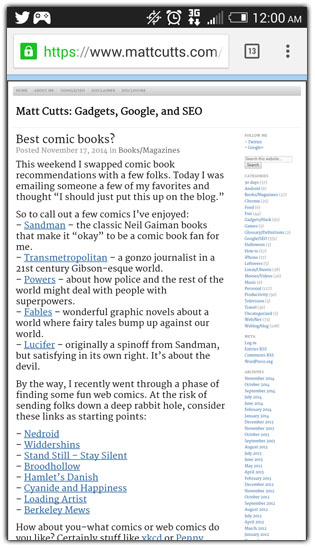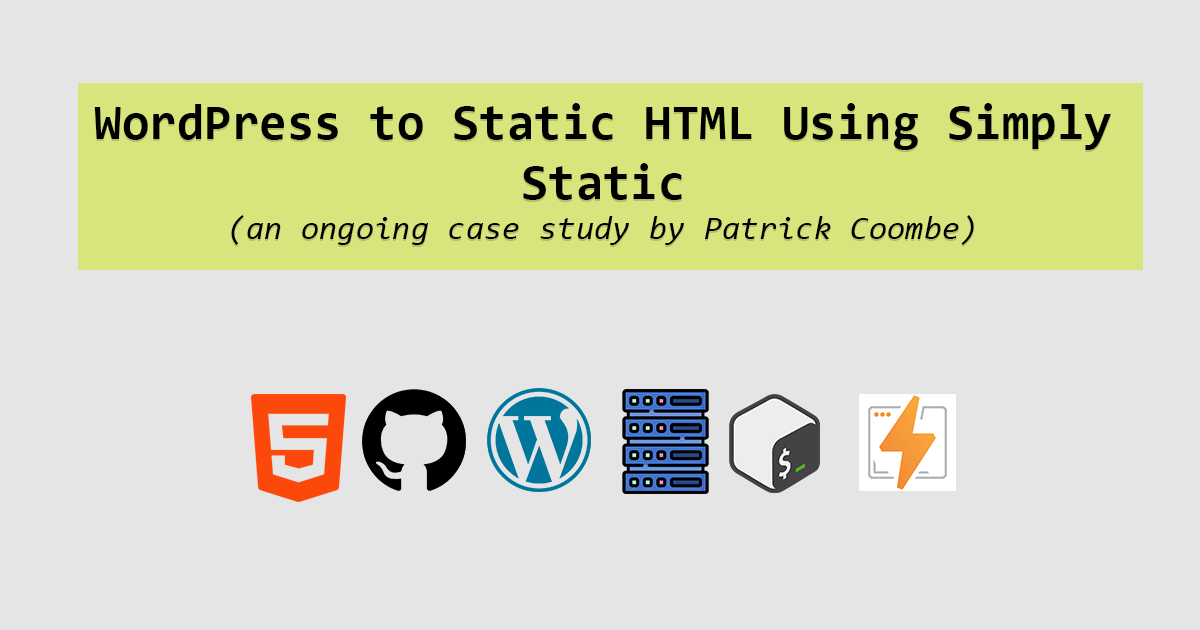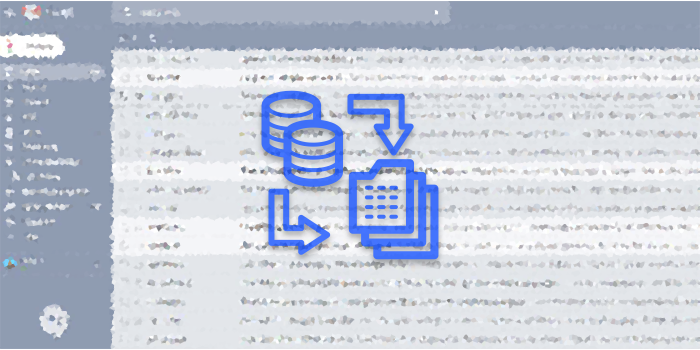A friendly SEO audit of MattCutts.com

Note: Per the title, this is a friendly audit and more of a project-style post and not an attack or personal criticism of Matt in any way. I resepect Matt as an engineer and a person.
To start off, it is worth noting that this is the epitome of a non-commercial hobby blog. He is not selling anything, has no affiliate links and makes every effort to have full transparency in regards to his affiliations and intentions. Matt’s blog has obviously gained the attention of SEO’s worldwide, but has also sparked some interest from many individuals via his “30 day challenges,” the open source developer community, and many other categories.
Content audit
Overall Matt’s content is well researched, very well written, and relevant to his interests which covers everything from SEO, Linux, Google culture, hardware hacking, and everything in between. His most popular category is “SEO” with a whopping 553 posts.
Matt carefully crafts and curates each post knowing that each and every word is scrutinized by the SEO / hacker community and his junior and senior colleagues at Google. As a result of that, most of his posts come out looking great. The word count truly varies depending on the posts. Some posts are just a few paragraphs while others are 1000+ words.
If you count a lot of his UGC (mainly comments) one might say he has quite a few posts that exceed 5000 words or more.
Some of his posts are so popular it sees 500+ blog comments from all sorts of industry folk. Most recently “The decay and fall of guest blogging for SEO” has nearly 700 comments and is quite possibly the most popular post on his blog.
Since 2005 the subject matter of his content has pretty much remained the same: Gadgets, Google, and SEO.
User Experience
If I were to choose 1 word to describe the user experience of Matt’s blog it would be “minimalistic.” The blog is extremely intuitive and easy to browse, all menus and links are well labeled. and there are no fancy tricks that get in the way.
Mattcutts.com is an excellent domain choice and definitely easy to remember. When landing on the root of his domain “mattcutts.com” you might find that this page is rather thin, and more of a doorway to the rest of his blog.
The favicon, a black “G” left me a tad confused. I couldn’t tell if it was the Google logo at first or a C. Either way this is not a Google blog, it is a personal blog and the favicon should represent Matt’s “brand” properly. I do kind of get his allegiance to the company that he has been so loyal to.
Mobile user experience has room for improvement. While easy to navigate, text was small and difficult to read.
Google’s own mobile testing tool gave this website a very poor score and made a number of recommendations to improve.

Although the site is technically not mobile friendly, when browsing it in the real world it isn’t horrible. The text could be a bit bigger and it is a tad difficult to tap some of the targets (links) being that there are so many in the sidebar.

The domain and server
Out of respect for Matt, I didn’t run any intrusive tests or fingerprinting on the server, but it does appear to be sitting on some sort of *nix box as it is an Apache server thanks to my favorite browser addon Wappalyzer. Matt also loves Linux and Ubuntu in particular. Again, just a guess.
From a WHOIS query, it appears as though the domain is registered with Gandi.net (tagline: ‘no bullshit’) and is hosted with a company named Tiger Technologies. The domain was registered in 2003 and appears to be free from any issues.

A unique choice for both domain regristrar and hosting, but Matt is an “ain’t broke don’t fix it” type of guy and my guess is it hasn’t broke in over 20 years.
SEO considerations
Matt’s blog is a PageRank 5 and has a Moz Domain Authority of 84 and /blog has a Page Authority of 64.
He no-indexes his category and tag pages. He also does not allow Yahoo Directory or the ODP to crawl his site as evidenced by the “noodp” and “noydir” which seems to appear in most of his page source code.
You’ll find the rel=”canonical” tag within the head of almost every post, page and category throughout the site. This is a common practice in WordPress blogs especially with multiple archives and such that generates similar looking content to google bot.
For one reason or another, Matt chooses not to use traditional meta description tags in any of the pages that I checked. Google serves up descriptions straight from his content, which he seems perfectly happy with:

He does use Open Graph titles/ descriptions and other tags by way of the WordPress Jetpack plugin. Definitely no sign of any meta-keywords tag or other meta nonsense.
He generally keeps his title tags under 70 characters, usually under 50 in most of the cases that I pulled.
The permalink structure is simplistic, yet relevant. Instead of categories, the framework has been modified to use “type” instead. So for instance his “Google / SEO” category is:
https://www.mattcutts.com/blog/type/googleseo/
Matt does a great job of providing an “alt” for his images anytime they are present:
<img src="https://www.mattcutts.com/images/ca-ad.jpg" alt="Photomosaic of people in an office">
I am sure this is more of a habit than an SEO consideration. Many “older” hackers have grown up using plain text browsing and are used to doing this. It is also a very polite gesture for people with accessibility issues.
Matt has outbound links to his personal Twitter and Google+ accounts site wide. The rest of his sidebar / widget area is pretty vanilla WordPress.

Referring domains snapshot courtesy of Ahrefs. Pretty much the best link portfolio ever.
Matt’s blog collects a steady stream of juicy do-follow backlinks from all over the world that has totaled over a half million total links to date. Many of these links have a very high authority, some of which are from various US and abroad governmental institutions as well as universities worldwide. Some of the top linking domains include, but certainly not limited to are:
- adobe.com
- en.wikipedia.org
- cnn.com
- huffingtonpost.com
- mashable.com
- lofter.com
- mozilla.org
- quantcast.com
- joomla.org
Google has indexed about 1250 pages on his domain and seems to have respected the noindex tags for type (category) and tags.
The site appears to be missing a sitemap.xml (did not dig further than the obvious defaults) and has a very simplistic robots.txt file.
There is a custom 404 page:
e.g. - https://www.mattcutts.com/blog/type/googleseo/asdf
Over the past few months the Alexa rank for this domain has dropped considerably. One might say this is due to him being “out of the limelight” and no longer being the face of Google / SEO. Other theories are that other blogs has surpassed his in popularity.

Matt has remained true to his geek roots and has been blogging now maybe more than ever. The subject matter has changed somewhat, with only 2 posts being about his most popular category “SEO” (one of which was an April Fools joke) since he went on hiatus.
The framework / stack
Mattcutts.com uses the WordPress framework and a few very basic libraries such as Google Font via a WordPress plugin by Adrian3.com.
The theme is a hacked together child theme based on the WordPress Genesis framework with an author URI of themeshaper.com.
Based on archive.org, it appears as though the site has been running on WordPress since 2005 and there really hasn’t been a whole lot of change over the years. He has used a few different themes. In 2009 he ran “Almost Spring” (now retired) theme.
The site also appears to be running Google Analytics and the WP Super Cache Tool and Google Font API primarily to load “Merriweather” font used in the body and header portion of his blog.
Matt is also using an interesting plugin called Cookies for Comments which uses an interesting tactic / method for reducing SPAM within the WordPress comment system. This plugin is loaded in his footer.
Page Speed
Most pages load in about 1 second per my own tests. The stack is extremely efficient and normally loads under 20-40 requests total and in under 1 second, depending on the page or post. Most pages do not exceed 100 Kb with some exceptions.
An average category page has about 272 lines of HTML.
An average post has about 675 lines of HTML.
The site is very snappy and always seems to load fast. I don’t know what kind of hosting plan he has, but I imagine it is something that can handle quite a bit of traffic at a time. Matt has had a ton of trending posts on HN over the years which has been known to serve up to 100k visits in a day if it stays on the front page.
Closing thoughts
Obviously this blog has achieved much success. The fact that it has been ranking for “SEO blog” for as long as I can remember is testament to its success. As with any website, there is always room for improvement.
If I were consulting Matt on his blog and were to make only 1 fix it would be the layout / nav. The sidebar is a bit overwhelming and mobile browsing leaves much to be desired. I would venture to guess that doing a retheme with any sort of bootstrap or Zurb responsive style theme would keep visitors on the site a much longer time and heck might even give the site a boost in the mobile SERPs.
This site is a perfect example of a website that has not implemented every SEO trick in the book and still achieved quite a bit of success. Perhaps this was Matt’s intention? The fact is even if you have a ton of “help” by being an authority figure, it still helps to have an optimized website to try and rank for as many keywords as possible.



